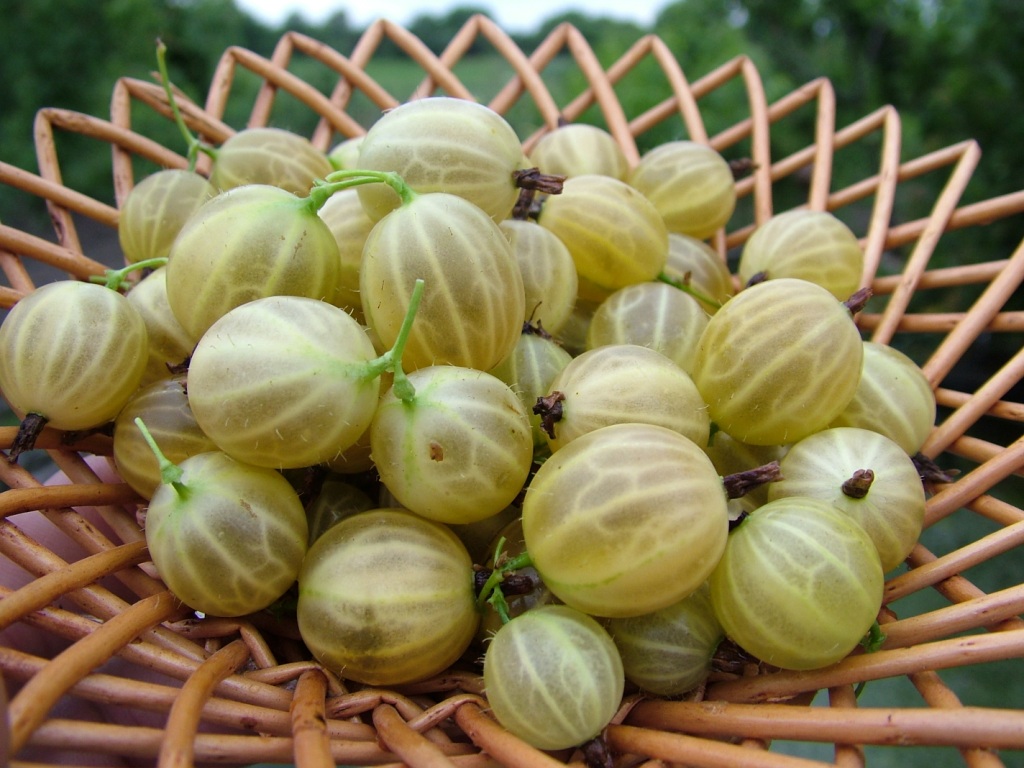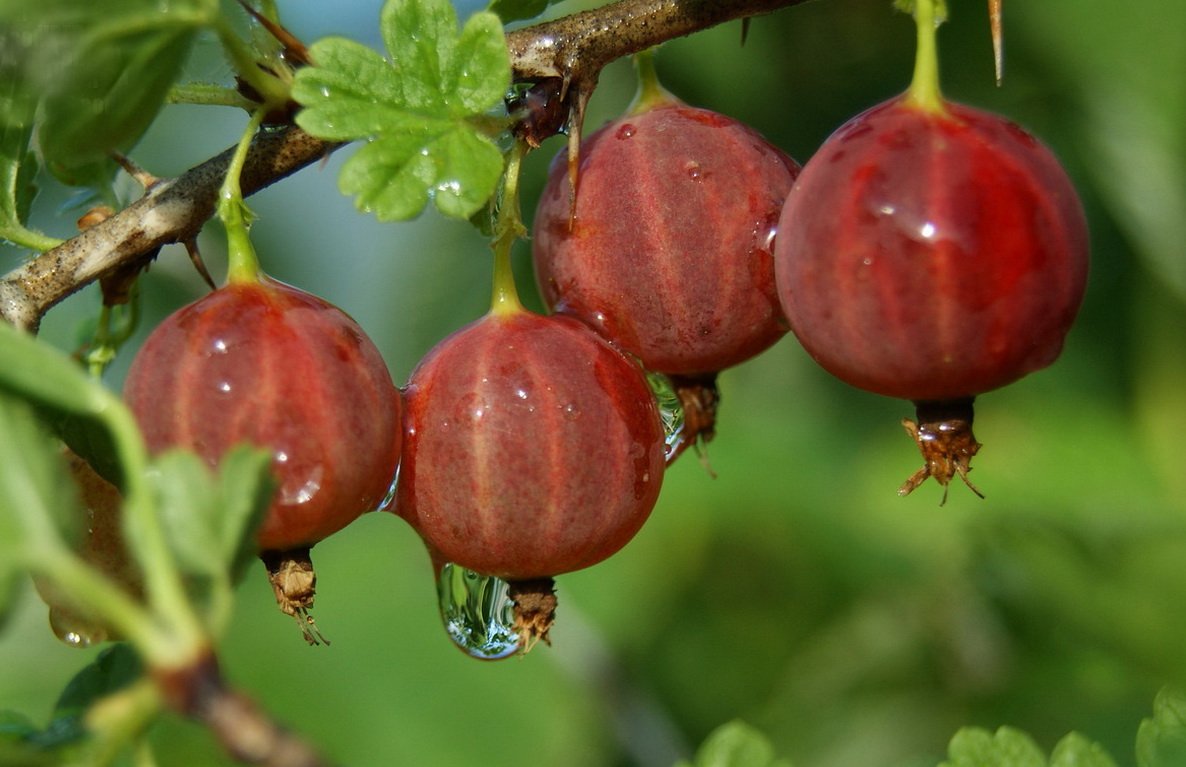 One of the many well-known cultivated plants that can often be found in summer cottages is the gooseberry. The homeland of this representative of the Smorodinovs is North Africa. It is also common in Western Europe. Wild gooseberry species are widely represented in the Caucasus and North America.
One of the many well-known cultivated plants that can often be found in summer cottages is the gooseberry. The homeland of this representative of the Smorodinovs is North Africa. It is also common in Western Europe. Wild gooseberry species are widely represented in the Caucasus and North America.
The first information about this plant became available in 1536, when the description of the gooseberry was compiled by Ruel. Subsequently, through hard work, American breeders were able to create hybrids that are resistant to powdery mildew.
Today, gooseberries are widespread, so they can be found in almost every country.
Content
Description of gooseberry bushes
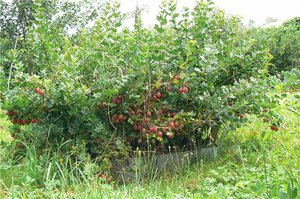 Usually this crop grows in bush form. It is customary to refer to it as a medium-sized plant, given that it can reach 120 cm in height.Gooseberry has a gray-brown bark, the branches are covered with thorns.
Usually this crop grows in bush form. It is customary to refer to it as a medium-sized plant, given that it can reach 120 cm in height.Gooseberry has a gray-brown bark, the branches are covered with thorns.
During the growing season, young shoots of a cylindrical shape are formed, which are often decorated with thin thorns. At the same time, there are known gooseberry varieties that have no thorns.
The leaves are large in size, they can grow up to 6 cm, the characteristic shape is round. Already in May, the gooseberry begins to bloom, at this time of the year the flowers become reddish or greenish.
During the fruiting period, oval berrieswhich are usually smooth or have small bristles. They are small in size - no more than 12 mm. However, there are varieties that can grow fruits up to 40 mm in size.
Gooseberries ripen in July or August. They can have a variety of colors - green, yellow, red and white. The presence of organic acids and salts of many metals makes the fruits valuable.
Unlike many other plants, gooseberries are self-fertile culture... Therefore, by planting only one bush on the site, you can regularly harvest these berries for many seasons.
When to plant gooseberries
Like any other culture, gooseberries provide certain features regarding their planting and care in the open field. You can plan the planting of young plants in spring or autumn. In the latter case, the time is chosen between the end of September and the middle of October.
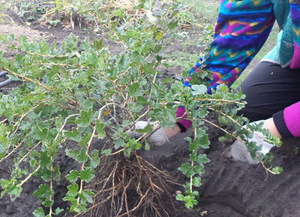 You need to be especially careful when choosing a place for gooseberries. This is important because the shrub has elongated roots. Therefore, the lowland is not a suitable place for planting it. Otherwise, you run the risk of facing fungal diseases when growing it.
You need to be especially careful when choosing a place for gooseberries. This is important because the shrub has elongated roots. Therefore, the lowland is not a suitable place for planting it. Otherwise, you run the risk of facing fungal diseases when growing it.- Experts recommend placing gooseberries in sunny areas on a plain or hill. Particular attention must be paid to ensure that the place for the gooseberry is protected from the wind.
- The gooseberry bushes are the most productive when planted on sandy or clay soil. However, it is necessary to regularly loosen the soil.
You can plant gooseberry bushes in spring or autumn... And, although this process is not much different in agricultural technology, it is still best to plan planting in the fall.The fact is that when young seedlings are planted in October, the chances are increased that they will winter well and begin to grow in the spring.
Planting gooseberries in autumn
 One of the unpleasant operations when planting and growing gooseberries is weeding. It is not very pleasant to do this due to the fact that the plant has many thorns. To save yourself from such problems, it is recommended to remove weeds in early autumn.
One of the unpleasant operations when planting and growing gooseberries is weeding. It is not very pleasant to do this due to the fact that the plant has many thorns. To save yourself from such problems, it is recommended to remove weeds in early autumn.
But at the very beginning need to dig the groundwhere you plan to plant the bushes. This must be done very carefully as it is important to make sure that no weeds are left in the ground.
After that, they move on to preparing the site for planting gooseberries. To do this, the surface must be leveled using a rake. The soil should be loose, so the earth clods need to be thoroughly broken.
When two weeks remain until the day of planting the bushes, start to prepare pitsto shape into a cube. The length of the sides of the pit should be 0.5 m each. This is done in advance so that the soil can settle before the planting begins.
It is imperative to remove the bottom layer of the earth and mix it with fertilizer... If clay soil prevails in the selected area, then additionally a bucket of river sand must be added to the mixture.
- If you plan to plant several gooseberry bushes, then it is recommended to place them at least 1-1.5 m apart. It is necessary to maintain a distance of at least three meters between the rows of bushes.
- It is best to plant bushes at the age of 1-2 years. Usually they already have a well-developed root system, reaching a length of about 30 cm. They must have several strong shoots.
- Even before planting seedlings, you need to place the roots in a fertilizer solution for a day. To prepare it, you need to take three or four tablespoons of nutrients and stir in 5 liters of water.
- Young gooseberry plants are placed in the pit so that they are located in it with a slight slope. The roots must be given a natural position, while the root collar should be located slightly below ground level.
- After that, they begin to fill the pit with earth in small portions. Moreover, from time to time it is necessary to compact it.
- The planted bush needs to be watered - usually one bucket of water is enough for one plant. When the moisture is absorbed, the soil surface is covered with mulch - peat or humus. After that, the branches are pruned, as a result of which no more than 5-6 buds should remain on each segment.
If you want to get a beautiful, healthy and productive gooseberry bush, then you need exactly follow the landing rules and caring for him.
Spring care
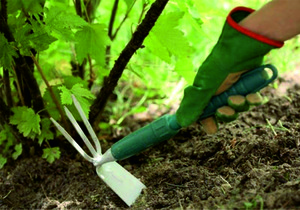 At the first sign of approaching spring, you need to start caring for the gooseberry. Any gardener, regardless of experience, can equally successfully cope with this task. For this, it is only important to know the basic agrotechnical rules and follow them.
At the first sign of approaching spring, you need to start caring for the gooseberry. Any gardener, regardless of experience, can equally successfully cope with this task. For this, it is only important to know the basic agrotechnical rules and follow them.
When it starts to get warmer outside, but snow will still be present in some places, processing bushes gooseberries with boiling water using a spray bottle. Such a "shower" will help to avoid the early appearance of pests and diseases.
In early May they spend loosening the soil in the root zone. It is important that the soil is treated to a depth of 10 cm. After that it must be covered with a layer of mulch. At the same time, they begin to carry out the first feeding.
Spring and early summer are the periods when the moisture deficit is especially acute in gooseberries. To provide the plant with water, it is recommended to carry out subsurface or drip irrigation.
Using these methods, it is possible to ensure the flow of moisture directly to the root system, which is located at a depth of 5 to 40 cm.About five such irrigations should be carried out per season. In this case, it is extremely unacceptable to use cold water.
If you decide to start growing gooseberries, then in the process of leaving you need to take care of creating support for the low hanging branches. Usually for these purposes they use stretch marks or nets, which are set at a height of approximately 30 cm between the rows.
Autumn care
In the process of caring for gooseberries in the fall, the gardener is required to prepare the bushes for winter. A mandatory event at this time of the year is feeding.
As a result of fertilization, fruit buds begin to form in the gooseberries in order to start growing the next year. In addition, in the fall bushes need pruning.
It is not recommended to postpone this operation to the spring, as this will make the bushes weakened, and this makes them less resistant to various diseases.
Top dressing of gooseberries
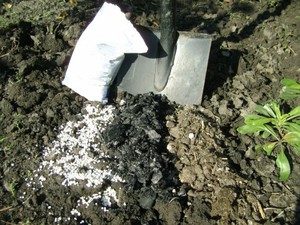 Every gardener who decides to grow gooseberries in his garden should know that in order for the fruits to ripen, it is necessary to take care of the plant for many years. Moreover, in the process of leaving under the bushes, you regularly need to apply fertilizers that he needs in large quantities.
Every gardener who decides to grow gooseberries in his garden should know that in order for the fruits to ripen, it is necessary to take care of the plant for many years. Moreover, in the process of leaving under the bushes, you regularly need to apply fertilizers that he needs in large quantities.
In order to fill the deficit of all elements, it is recommended to use mineral and organic feeding... Therefore, if you do not want to regularly fight gooseberry diseases and get a high yield of berries every season, then you need to regularly apply nutrients under the bushes.
The following mixture is suitable as dressings: you need to take half a bucket of humus, mix it with 50 g of superphosphate, as well as ammonium sulfate and potassium sulfate, taken 25 g each.
This fertilizer is sufficient to provide nutrients to a normal sized bush. If the bush is quite large, then you will need to double the indicated components.
The fertilization zone is determined along the perimeter of the crown. Each top dressing must be completed by loosening the soil.
After the gooseberry blossoms, as well as two weeks later, additional add mullein solution... To prepare it, take 1 part of the mixture and dilute in 5 parts of water. At least 5 liters of solution must be applied to one plant.
Gooseberry diseases
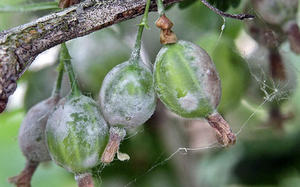 Big enough harm can cause gooseberry bushes powdery mildew... It is also known as the spherotek. It is enough for this disease to hit the bush once for the gardener to be left without a crop.
Big enough harm can cause gooseberry bushes powdery mildew... It is also known as the spherotek. It is enough for this disease to hit the bush once for the gardener to be left without a crop.
At the first sign of powdery mildew, you must immediately take measures to combat it, otherwise a couple of years will pass and the plant will completely die. The most favorable conditions for powdery mildew occur on days when the weather is warm and humid.
The characteristic signs of powdery mildew are the appearance on all parts of the plant, including berries, loose white bloom... Subsequently, it turns into a brown crust. If a plaque appears on the shoots, then over time they begin to bend and gradually dry out.
The leaves become brittle and fall off, and the fruits, before reaching the stage of maturity, crumble to the ground. It is possible to avoid the defeat of the bushes with this disease if, even before flowering, they are sprayed with a solution of a preparation containing copper "HOM". To prepare the product, take 40 g of the drug and dilute it in 10 liters of water.
Also, no less dangerous diseases for gooseberries are anthracosis, mosaic and goblet rust.
Mosaic. This disease is caused by viral pathogens. If the bushes have signs of this disease, then it will not work to help him. In such situations, you need to as soon as possible dig up the affected bushes and burn them.
For other plants, you can try the following treatment. Spraying can help to combat mosaic “Nitrafen "or copper sulfate.
Gooseberry varieties
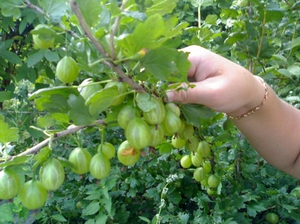 Considering that today many different varieties of gooseberries have been bred, various methods of planting and care, reproduction and treatment are applied to them.The entire variety of plants can be represented as two groups.
Considering that today many different varieties of gooseberries have been bred, various methods of planting and care, reproduction and treatment are applied to them.The entire variety of plants can be represented as two groups.
It is customary to refer to the first European gooseberry species... A characteristic feature of the bushes is a longer fruiting period, during which large berries are formed. The weak point is low resistance to various pests and diseases.
The second group is formed by hybrid varietieswhich are also known as American-European. They are not so often affected by diseases. Other varieties of gooseberries are also distinguished, depending on the location of the thorns. The most famous plants that lack thorns are:
- eagle;
- serenade;
- tender;
- studless pear-shaped.
The gooseberry is rightfully popular among many gardeners. After all, it not only can be very productive, but also does not require pollination in the process of growing.
However, in order to get a lot of berries from gooseberry bushes, they need provide appropriate care... Watering is mandatory, which must be carried out strictly in the root zone.
It is equally important to provide the shrub with nutrients, since as the yield increases, the gooseberry's need for various elements also increases.
